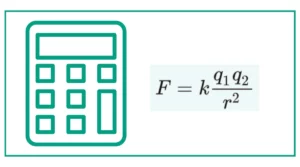Force Calculator (F=Ma)
Force calculator helps you calculate the force, acceleration, and mass through Newton’s second law of motion i.e. F=Ma.
Enter the mass in kg, and acceleration to find the force.
Enter force and acceleration to find the mass.
Enter mass and force to calculate the acceleration.
Newton’s second law is F=ma.
Newton’s second law quantifies how force affects motion. It states that a body’s momentum change is proportional to the force applied to it.

You might be interested in calculating work or finding attraction or repulsion.
Understanding Newton’s Second Law
This fundamental principle of physics is expressed by the equation:
F = m × a
Where:
- F is the net force acting on an object (measured in Newtons, N)
- m is the mass of the object (measured in kilograms, kg)
- a is the acceleration of the object (measured in meters per second squared, m/s²)
This equation forms the basis of our force calculator and is crucial for understanding various physical phenomena.
How to Use the Force Calculator
Using the force calculator is straightforward. Follow these steps to perform your calculations:
- Identify the known variables: Determine which two of the three variables (force, mass, or acceleration) you already know.
- Input the known values: Enter the values you know into the appropriate fields of the calculator.
- Select the unknown variable: The calculator will automatically determine which variable you want to calculate based on the inputs provided.
- Click “Calculate”: The force calculator will process the information and display the result.
Example 1: Calculating Force
Let’s say you want to calculate the force required to accelerate a 2000 kg car from 0 to 100 km/h (27.78 m/s) in 10 seconds.
- Calculate the acceleration: a = (27.78 m/s) / 10 s = 2.778 m/s²
- Input the mass: m = 2000 kg
- Input the acceleration: a = 2.778 m/s²
- Click “Calculate”
The force calculator will show that the force required is:
F = 2000 kg × 2.778 m/s² = 5556 N
This means a force of 5556 Newtons is needed to accelerate the car as described.
Applications of the Force Calculator
The force calculator has numerous practical applications across various fields:
Physics and Engineering
In physics and engineering, the force calculator is invaluable for solving problems related to motion, design, and analysis. Engineers use it to calculate the forces acting on structures, machines, and vehicles, ensuring they can withstand the stresses they’ll encounter.
Sports and Fitness
Athletes and fitness enthusiasts can use the force calculator to analyze performance and design training programs. For example, calculating the force exerted during a jump or the acceleration of a sprinter can provide insights for improvement.
Transportation
In the transportation industry, the force calculator helps in designing vehicles, determining fuel efficiency, and analyzing safety features. It’s crucial for calculating braking distances, impact forces in collisions, and the power needed for different driving conditions.
Advanced Concepts: Net Force and Vector Quantities
While the basic force calculator deals with scalar quantities, it’s important to note that force is actually a vector quantity, meaning it has both magnitude and direction. In real-world scenarios, multiple forces often act on an object simultaneously. The net force is the vector sum of all these individual forces.
To calculate the net force, you need to consider both the magnitude and direction of each force acting on the object. This often involves more complex calculations using trigonometry or vector algebra.
Example 2: Calculating Net Force
Imagine a box being pushed by two people. Person A exerts a force of 50 N to the right, while Person B exerts a force of 30 N to the left.
To calculate the net force:
- Assign positive values to forces acting to the right and negative values to forces acting to the left.
- Sum the forces algebraically.
Net Force = 50 N + (-30 N) = 20 N to the right
In this case, the force calculator can help you determine the acceleration of the box if you know its mass, using the net force as the input.
Other Related Physics Calculators
While the force calculator is a powerful tool, it’s just one of many physics calculators available to help with various calculations. Here are some related calculators you might find useful:
Kinetic Energy Calculator
Kinetic energy is the energy possessed by an object due to its motion. The kinetic energy calculator uses the formula:
KE = (1/2) × m × v²
Where:
- KE is kinetic energy (measured in Joules, J)
- m is mass (in kg)
- v is velocity (in m/s)
Potential Energy Calculator
Potential energy is the energy stored in an object due to its position or configuration. For gravitational potential energy, the calculator uses the formula:
PE = m × g × h
Where:
- PE is potential energy (in Joules, J)
- m is mass (in kg)
- g is the acceleration due to gravity (approximately 9.8 m/s² on Earth)
- h is height (in meters)
Centripetal Force Calculator
Centripetal force is the force that makes an object move in a circular path. The centripetal force calculator uses the formula:
F = m × v² / r
Where:
- F is the centripetal force (in Newtons, N)
- m is mass (in kg)
- v is velocity (in m/s)
- r is the radius of the circular path (in meters)
Practical Applications of Force Calculations
Understanding and calculating forces is crucial in many real-world scenarios. Here are some practical applications where force calculations play a vital role:
Construction and Architecture
Engineers and architects use force calculations to ensure buildings and structures can withstand various loads, including their own weight, wind forces, and seismic activity.
Automotive Design
Force calculations are essential in designing safe and efficient vehicles. They help determine the strength of materials needed, the effectiveness of safety features, and the performance characteristics of the vehicle.
Aerospace Engineering
In aerospace, force calculations are critical for designing aircraft and spacecraft that can overcome gravity, air resistance, and other forces encountered during flight.
Biomechanics
Force calculations help in understanding human movement, designing prosthetics, and developing ergonomic equipment to prevent injuries.
References
- Pourciau, B. (2006). Newton’s interpretation of Newton’s second law. Archive for history of exact sciences, 60(2), 157-207.
- Newton’s laws of motion – Wikipedia. (2022, January 25). Newton’s Laws of Motion – Wikipedia. en.wikipedia.org/wiki/Newton%27s_laws_of_motion





